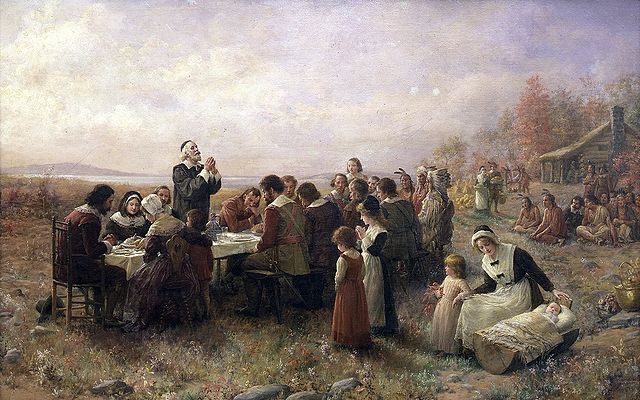The Mayflower Compact, originally titled Agreement Between the Settlers of New Plymouth, was the first governing document of Plymouth Colony. It was written by the men aboard the Mayflower, consisting of Separatist Puritans, adventurers, and tradesmen. Although the agreement contained a pledge of loyalty to the King, the Puritans and other Protestant Separatists were dissatisfied with the state of the Church of England, the limited extent of the English Reformation and reluctance of King James I of England to enforce further reform.
Signing the Mayflower Compact 1620, an 1899 painting by Jean Leon Gerome Ferris
Bradford's transcription of the Compact
1920 U.S. postage stamp depicting the signing of the compact
Signing of the Mayflower Compact Bas-relief by Cyrus Dallin at the Pilgrim Monument Provincetown, Massachusetts
Plymouth Colony was the first permanent English colony in New England from 1620 and the third permanent English colony in America, after Newfoundland and the Jamestown Colony. It was settled by the passengers on the Mayflower at a location that had previously been surveyed and named by Captain John Smith. The settlement served as the capital of the colony and developed as the town of Plymouth, Massachusetts. At its height, Plymouth Colony occupied most of the southeastern portion of Massachusetts. Many of the people and events surrounding Plymouth Colony have become part of American folklore, including the American tradition of Thanksgiving and the monument of Plymouth Rock.
The cover of John Smith's A Description of New England, published in 1616, which was the first text to use the name "New Plymouth" to describe the site of the future colony
Interview of Samoset with the Pilgrims, an 1852 book engraving
"Signing of the Mayflower Compact" by Edward Percy Moran, c. 1900
The First Thanksgiving at Plymouth, a 1914 portrait by Jennie Augusta Brownscombe that is now housed in Pilgrim Hall Museum in Plymouth, Massachusetts








